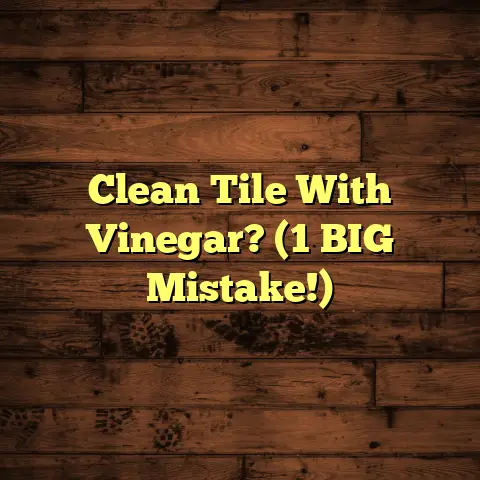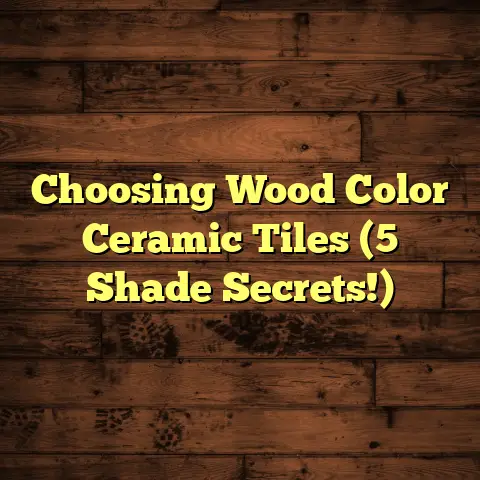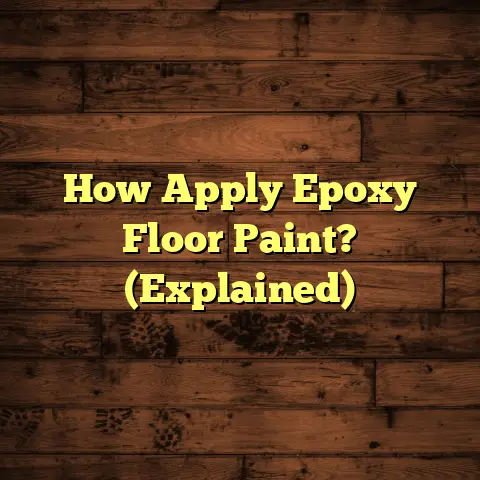Refinish Wood Floors Cost? (5 Factors Change Price!)
And one question I get asked all the time is: “How much does it really cost to refinish wood floors?”
Well, you’re in the right place! Refinishing wood floors is like giving your home a facelift.
It not only boosts the beauty of your space but also makes life a whole lot easier. Think about it: wood floors are a breeze to clean compared to carpets or tile.
A quick sweep or mop, and you’re done!
Refinishing takes that ease to the next level.
A smooth, newly refinished surface means less dust buildup and spills that wipe up in a snap.
Plus, it’s a win for hygiene, especially in those high-traffic zones.
In this article, I’m going to break down the real costs of refinishing, diving deep into the factors that can dramatically shift the price.
Let’s get started!
Understanding the Cost of Refinishing Wood Floors
So, what does refinishing actually involve?
Basically, we’re talking about sanding down the old finish, repairing any imperfections, staining (if you want a new color), and then sealing it all up with a protective topcoat.
Think of it as a spa day for your floors!
Now, the price tag? That’s where things get interesting.
On average, you might be looking at anywhere from $3 to $8 per square foot. But that’s just a ballpark.
I’ve seen projects range from a few hundred dollars for a small room to several thousand for an entire house.
The cost depends on many things. Let’s break down the big ones!
Factor 1 – Type of Wood
Believe it or not, the type of wood your floors are made of plays a huge role in how much the refinishing process will set you back.
Think about it: some woods are softer, some are harder, and some have unique grain patterns that require special attention.
Oak, for example, is a popular and relatively affordable choice. It’s durable and takes stain well.
Maple, on the other hand, is a denser hardwood that can be a bit trickier to stain evenly. This can add to the labor involved and potentially the cost.
Then you have exotic woods like Brazilian Cherry or Bamboo. These are often harder to work with and may require specialized equipment or techniques, leading to higher prices.
Here’s a quick rundown of how different woods can impact cost:
| Wood Type | Hardness (Janka Scale) | Refinishing Difficulty | Cost Impact |
|---|---|---|---|
| Oak (Red/White) | 1290 / 1360 | Moderate | Standard |
| Maple | 1450 | Moderate to High | Slightly Higher |
| Pine | 380-870 | High | Higher |
| Hickory | 1820 | Moderate | Standard |
| Brazilian Cherry | 2350 | High | Higher |
| Bamboo | Varies (typically high) | Moderate to High | Slightly Higher |
Note: Janka Hardness Scale measures the resistance of a sample of wood to denting and wear.
The harder the wood, the more resistant it is to scratches and dents. But it can also be more challenging (and therefore more expensive) to sand and refinish.
Softer woods like pine are more prone to damage and require a gentler touch, which can also add to the labor time and cost.
Factor 2 – Size of the Area
This one’s pretty straightforward: the more square footage you’re refinishing, the higher the overall cost will be.
It’s simple math, right?
But there’s a little more to it than just multiplying the square footage by the price per foot.
Larger projects often offer economies of scale.
What does that mean?
Well, contractors might be willing to offer a lower price per square foot for a bigger job because they can spread out their setup and travel costs.
For example, a 200-square-foot room might cost $8 per square foot to refinish, while a 1000-square-foot house might only cost $5 per square foot.
Here’s a hypothetical cost breakdown based on square footage:
| Square Footage | Average Cost per Sq Ft | Estimated Total Cost |
|---|---|---|
| 200 | $8.00 | $1,600 |
| 500 | $6.50 | $3,250 |
| 1000 | $5.00 | $5,000 |
| 1500 | $4.50 | $6,750 |
Keep in mind that these are just estimates.
The best way to get an accurate idea of the cost is to get quotes from several contractors.
Factor 3 – Condition of the Floors
Okay, this is where things can get a bit unpredictable.
The condition of your existing wood floors can have a major impact on the final price.
If your floors are in pretty good shape, with just some minor scratches and wear, the refinishing process will be relatively straightforward.
But if you’re dealing with deeper scratches, dents, water damage, or even pet stains, it’s a whole different ballgame.
These issues require extra prep work, such as:
- Extensive sanding: To remove deep imperfections.
- Wood replacement: Replacing damaged planks.
- Stain removal: Treating stubborn stains.
All of these add time and materials to the project, which translates to higher costs.
Water damage is a particularly nasty one. It can cause the wood to warp, buckle, or even rot.
In some cases, you might need to replace entire sections of flooring, which can significantly increase the cost.
Here’s how the condition of your floors might affect the price:
| Floor Condition | Additional Work Required | Cost Impact |
|---|---|---|
| Minor Scratches | Light sanding | Minimal |
| Deep Scratches | Extensive sanding, possible patching | Moderate |
| Water Damage | Wood replacement, subfloor repair | Significant |
| Pet Stains | Stain removal, odor treatment | Moderate to High |
| Uneven Boards | Leveling, sanding | Moderate |
Before you even get a quote, take a good hard look at your floors.
Note any areas that are particularly damaged or uneven.
This will give you a better idea of what to expect in terms of cost.
Factor 4 – Finishing Options
The finish you choose for your wood floors isn’t just about aesthetics; it also affects the cost, durability, and maintenance of your floors.
There are two main types of finishes: oil-based and water-based.
Oil-based finishes are known for their durability and rich, amber hue. They tend to be more affordable upfront, but they have some drawbacks.
They take longer to dry, emit strong odors, and can yellow over time.
Water-based finishes, on the other hand, are low-VOC (volatile organic compounds), dry quickly, and don’t yellow.
They’re also more environmentally friendly. However, they tend to be more expensive than oil-based finishes.
Beyond the base type, you also have different levels of sheen to consider:
- High-gloss: Very shiny and reflective, but shows scratches easily.
- Semi-gloss: A good balance of shine and durability.
- Satin: A low-luster finish that hides scratches well.
- Matte: A very flat finish that looks natural but may require more maintenance.
The type of finish and sheen you choose will impact the overall cost.
More durable finishes or specialized finishes (like those with UV protection) will generally be more expensive.
Here’s a quick comparison of oil-based and water-based finishes:
| Feature | Oil-Based Finish | Water-Based Finish |
|---|---|---|
| Cost | Lower | Higher |
| Durability | High | High (some are even higher than oil) |
| VOCs | High | Low |
| Drying Time | Longer | Shorter |
| Odor | Strong | Mild |
| Yellowing | Yes | No |
| Environmental Impact | Higher | Lower |
Think about your lifestyle and how you use your floors.
If you have kids or pets, you might want to invest in a more durable finish, even if it costs a bit more upfront.
Factor 5 – Labor and Geographic Location
Last but definitely not least, the cost of labor and where you live can significantly impact the price of refinishing your wood floors.
Labor costs vary widely depending on your region.
In areas with a high cost of living, like California or New York, you can expect to pay more for labor than in areas with a lower cost of living, like the Midwest or the South.
The experience and expertise of the contractor also play a role.
A highly skilled and experienced contractor will likely charge more than someone who is just starting out.
But remember, you get what you pay for!
Hiring an experienced professional can save you headaches (and money) in the long run.
DIY refinishing might seem tempting to save money, but it’s not for the faint of heart.
It requires specialized equipment, knowledge, and skill.
If you mess up, you could end up damaging your floors and costing yourself even more money to fix.
I’ve seen it happen countless times!
Here’s a general idea of how labor costs can vary by region:
| Region | Average Labor Cost per Sq Ft |
|---|---|
| Northeast | $3 – $6 |
| Midwest | $2 – $5 |
| South | $2 – $4 |
| West | $4 – $7 |
These are just averages, of course.
The best way to get an accurate idea of labor costs in your area is to get quotes from several local contractors.
When you’re getting quotes, be sure to ask about:
- Experience: How long have they been in business?
- Insurance: Are they properly insured?
- References: Can they provide references from previous clients?
- Warranty: Do they offer a warranty on their work?
Don’t just go with the lowest bidder.
Choose a contractor who is qualified, experienced, and reputable.
Conclusion
So, there you have it! The five key factors that can dramatically change the cost of refinishing your wood floors:
- Type of Wood: Harder woods or exotic species can increase costs.
- Size of the Area: More square footage means a higher overall cost, but potentially lower per-square-foot pricing.
- Condition of the Floors: Extensive damage requires more prep work and higher costs.
- Finishing Options: Oil-based vs. water-based finishes, and different sheen levels, impact the price.
- Labor and Geographic Location: Labor costs vary by region and contractor experience.
Refinishing your wood floors is an investment, no doubt about it.
But by understanding these factors, you can make informed decisions and avoid surprises along the way.
And remember, regular maintenance and care are key to extending the lifespan and beauty of your wood floors.
Sweep or vacuum regularly, use floor protectors under furniture, and clean up spills promptly.
With a little TLC, your refinished wood floors will look beautiful for years to come!





